As cities begin phased re-openings, what can businesses and our communities learn from the essential services that have weathered the pandemic thus far? While we continue to observe and draw insights from pandemic responses from around the world, we invite you to learn alongside us and take part in the creation of our New Abnormal.
COVID-19 has set off a chain of events that are reshaping many facets of daily life. This is especially palpable in retail sectors. Adapting quickly and thoughtfully may be the only way to survive. As the world adjusts, there will continue to be profound shifts in behaviors, standards, and expectations that govern the public environments where we live and where we shop. One of the most visited and critical places we see change in process is the grocery store.
Grocery Stores as Microcosm and Creative Engine
The grocery store is a microcosm of life, where peoples’ behaviors reflect the ebb and flow of economic and social change. Even before COVID-19, groceries have been a bellwether of societal change because they are a primary source of our most basic needs. As shoppers and store management alike have adjusted to the changing demands of self-isolation and social distancing, the pandemic has magnified consumer reactions to moving through a shared space.
In Abraham Maslow’s Hierarchy of Needs, people’s actions are motivated by the drive to satisfy five basic needs. In this upward hierarchy, basic physiological and safety needs, including food, water, health, and safety, must first be met before we attend to more advanced needs for love and belonging, esteem, and self-actualization. The pandemic has undermined our sense of health and safety, forcing us to refocus our attention on the more basic needs.
In periods of lockdown, people are no longer gathering in large groups, but grocery stores have become a necessary exception to that rule. This has opened a window into how people react under stress, and, in aggregate, how a community establishes new norms regarding thoughts and feelings. As people shop to support themselves and their families in tough times, we have seen this behavioral experiment unfold aisle to aisle and shelf to shelf in the grocery ecosystem.
Grocery stores were among the first to rapidly test ways to handle the chaos of new viral risks. They have been experimenting, correcting, and adjusting in real-time ever since; and though they may not be aware of it, their approach to making stores safer and their ingenuity in managing the influx of shoppers have mirrored the design process. This adaptation and management of constraints reflect the iterative process of idea generation, prototyping, and testing that designers rely on to quickly develop solutions to user needs and complex business problems.
So, while we may think of the design process as a structured system developed and practiced by design teams, I see these grocery stores and their management teams as designers in their own right, using fundamental design practices to reimagine their infrastructure given new constraints. With the observation of such parallels, my curiosity took over, and I began chronicling the grocery store transformation in a pandemic journal.
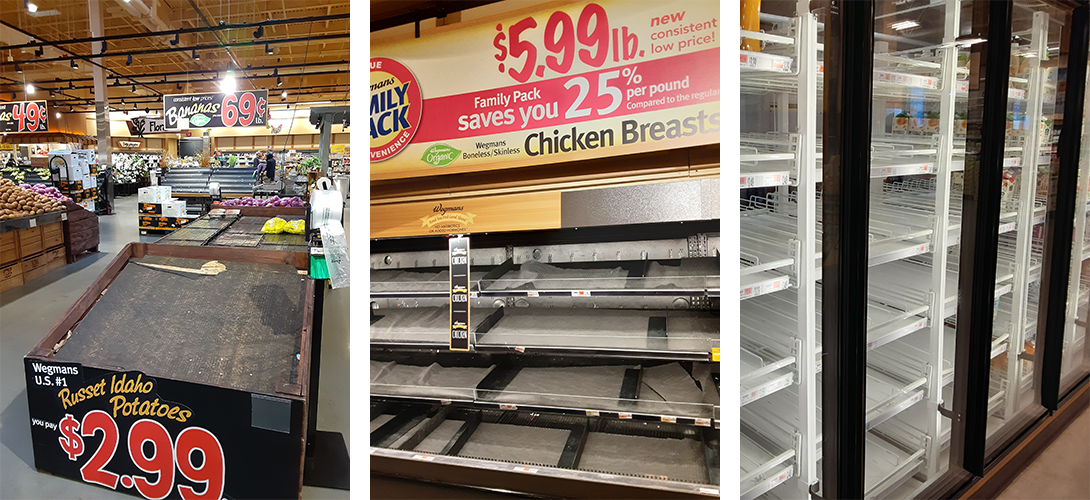 At a Wegmans in Massachusetts, shoppers encounter sold out potatoes and bananas, a shortage of fresh chicken, and an empty orange juice aisle.
At a Wegmans in Massachusetts, shoppers encounter sold out potatoes and bananas, a shortage of fresh chicken, and an empty orange juice aisle.
Pandemic Journal
Two days after the outbreak was labeled a pandemic, I visited several grocery stores around the Boston area, where I witnessed a sudden and drastic change in shoppers’ behaviors.
From the South End to Revere, I kept a journal detailing the diversity of approaches grocers were adapting in response and identified a consistent theme: those who were successful had adapted, testing new approaches and modifying them on the fly. It is a quick iteration process, not dissimilar to that of design.
The Wegmans in Malden, for example, created and implemented a plan almost immediately. It's an approach I’ve witnessed evolve over the first 6-8 weeks of the pandemic. Here are some of my observations of the iterative approach taken by this store:
Day 1: Many shoppers appear to be on a mission, determined to hunt down the last dozen eggs or racing to see if there is any pasta left on the shelves. At checkout, a store manager directs us to the back of a single line, which he oversees with the help of a walkie-talkie. This works to clear checkout lanes and create order; however, it also means we find ourselves at the back of the store in a long, snaking blockade where we wait half an hour to pay as our ice cream melts.
Day 7: The store has adapted since I was here last week. Hoarding has become a problem, and store stocks are suffering. Wegmans is now rationing high demand items, signaling precise quantities allowed per order with yellow tags on each affected SKU. This seems to have slowed the stockpiling tendencies and left limited canned vegetables and pasta for the rest of us. Helpful and friendly signs throughout the store reassure customers of efforts to keep us safe and maintain fairness in uncertain times.
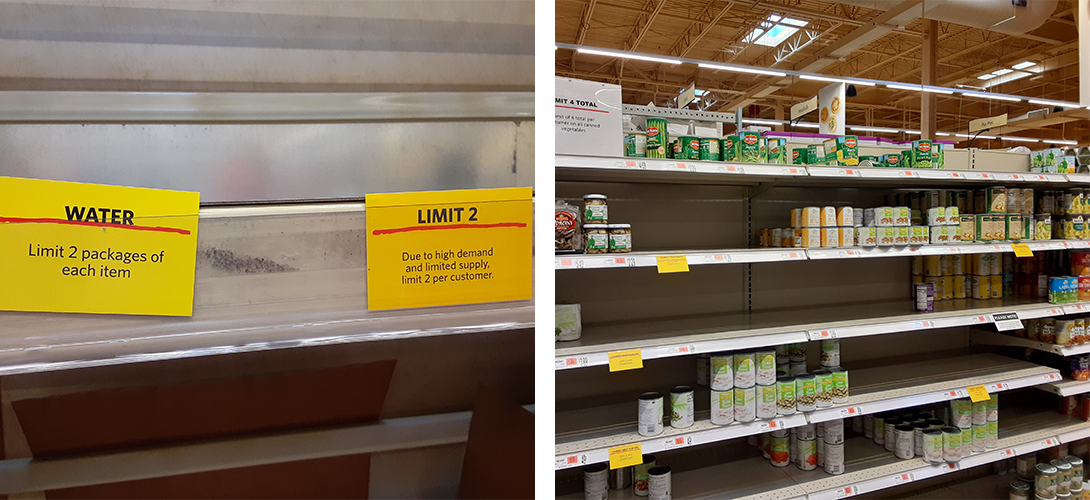 Friendly store reminders and yellow placards highlight quantity allowances for high-demand items.
Friendly store reminders and yellow placards highlight quantity allowances for high-demand items.
The checkout line has evolved, too. We’re back to individual cashier lanes with the modification of taped markings. Lines wait in the adjacent aisle while individuals work through three stages of checkout that reduce contact with employees. A manager is disseminating information on the new protocols and sending people up one at a time as registers become available. Wait times have dropped as a result, and for the first time, I am seeing a semblance of social distancing taking place. Hand washing stations are also installed behind the cashiers - new from the previous week.
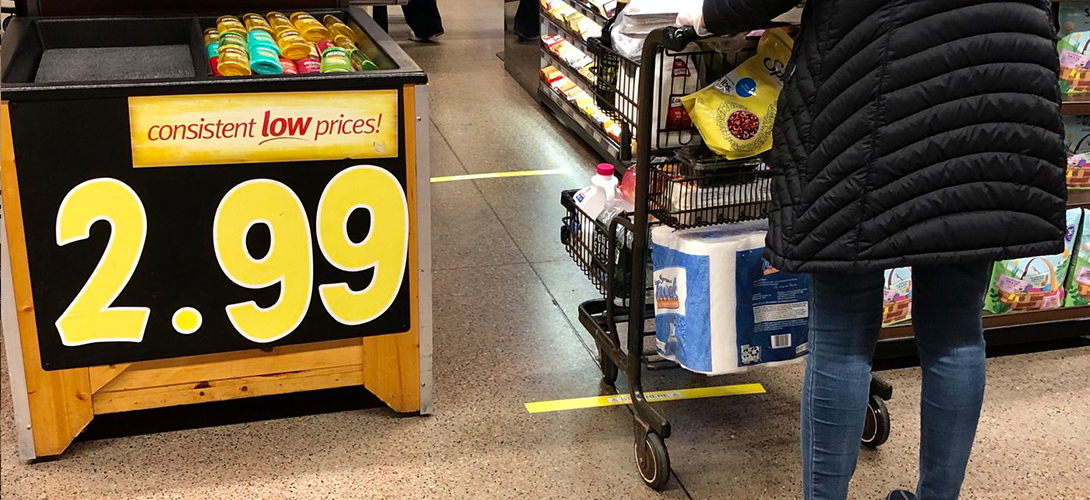 Social distancing marks on the floor guide a three-stage checkout.
Social distancing marks on the floor guide a three-stage checkout.
Day 14: All of the previous measures remain intact from last week, though I notice store employees are now stocking shelves round-the-clock. While social distancing occurs in the checkout lines, people shopping remain close together in the aisles, even more so than before, still sharing the space with dollies and stocking personnel. Despite the extra maneuvering to get around the store, the stocking effort appears to be having an effect as some hard-to-find products return to the shelves. This is reassuring customers that supplies will not be interrupted and that their intention was to get items into people’s hands as quickly as possible.
Most stores, including this Wegmans, no longer allow reusable bags. Plastic bags are brought back into circulation, despite last year's legislation that banned them. I wonder what this will mean for the sustainability movement in the shopping sector . . .
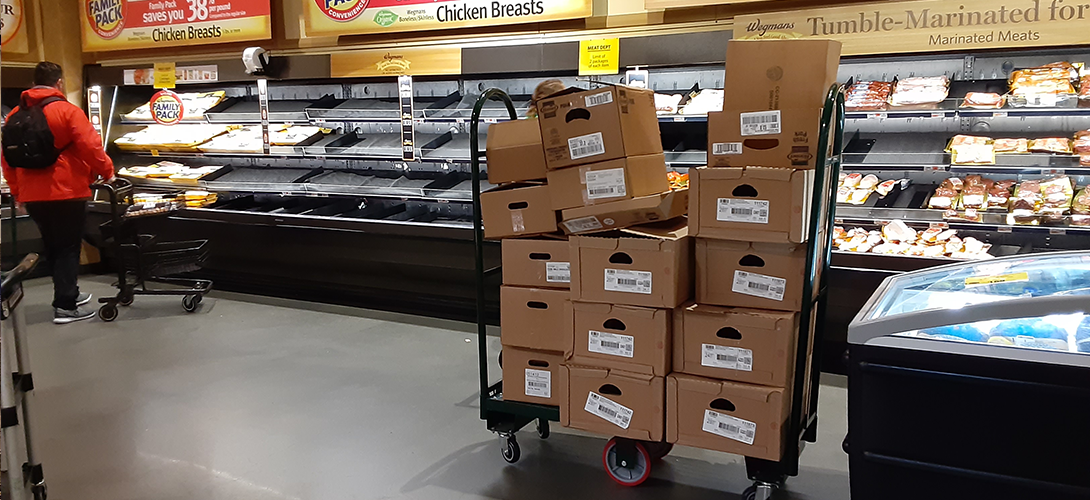
Dollies of produce and product in front of empty shelves reveal the struggle to keep up with demand.
Day 21: Wegmans has now instituted a $2 per hour raise as a “thank you” to support their workers on the front lines. Online announcements continue to be updated with helpful, encouraging, and informative messages.
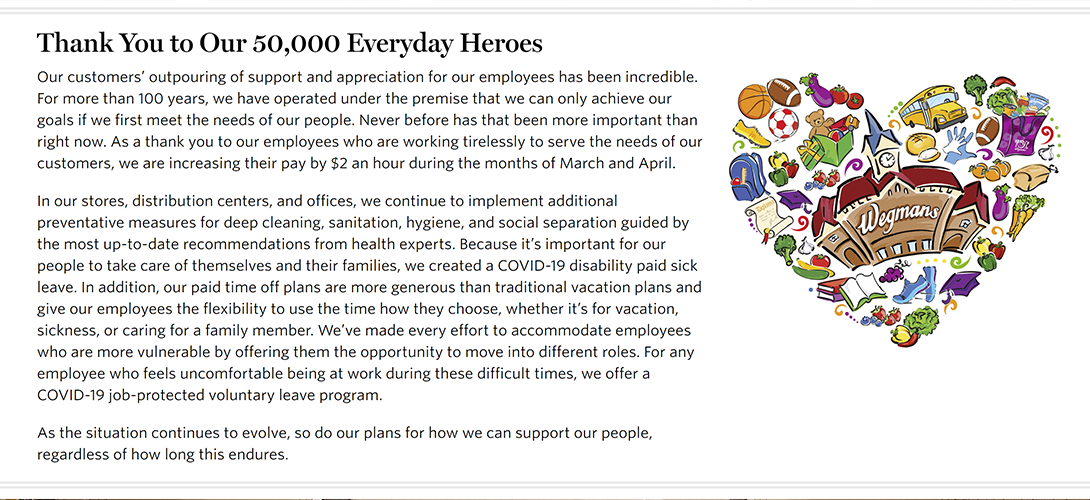 Wegmans' messaging campaign involves kind, clear, and timely updates of vital information, acting as a point of clarity and support in uncertain times.
Wegmans' messaging campaign involves kind, clear, and timely updates of vital information, acting as a point of clarity and support in uncertain times.
Day 28: I’ve overheard employees discussing plans of PPE to be provided by their employer. Social distancing measures are also being implemented along with reduced store capacity. This is the first time I’ve seen outdoor lines and spacing markers - helpful once I find the line, but not so much when I walk up to the usual entrance only to find it barricaded by carts.
Once I find the line on the other side of the store, I locate the next available spot at one of the many yellow dots beside the building. I’ve heard of other stores using tape, sidewalk chalk, and the natural spacing of concrete slabs to create the extra space in line, many making use of items in the environment to create logical spacing references (e.g., carts and floor tiles).
At this store, six feet apart and underdressed for the weather, people are fidgeting and finding spots in the sun to keep warm. Will it be the new normal to be stuck outside for 40 minutes in only a sweatshirt and face mask?
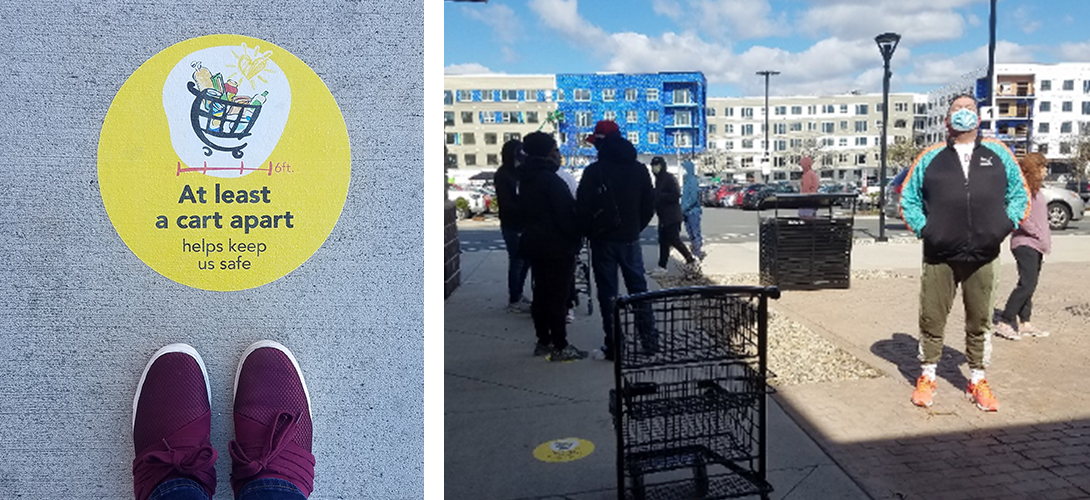
6 ft spacing stickers wrap around the shopping complex, encouraging shoppers to social distance as they wait in line.
As the line stretches to the other end of the shopping center, people are findings ways to keep spirits up by cracking jokes. Once inside the store, it feels relatively normal, though less crowded, and people are wearing face masks. The supply of pasta, veggies, and milk has returned for the first time in a month! Clear shields in front of cashiers are a new addition as well.
Oddly enough, produce has never been more neatly and carefully arranged! I pulled a pepper from the pile only to catch a store employee quickly reorienting and arranging peppers I may have toppled back into their rightful place. I wonder if this is simply to remain more engaged and take pride in his work, while spending hours doing one stocking activity or if there is “COVID logic” to the separation and presentation of peppers? Does this immaculate display reduce the need for people to sift through and touch more of the produce than they need?
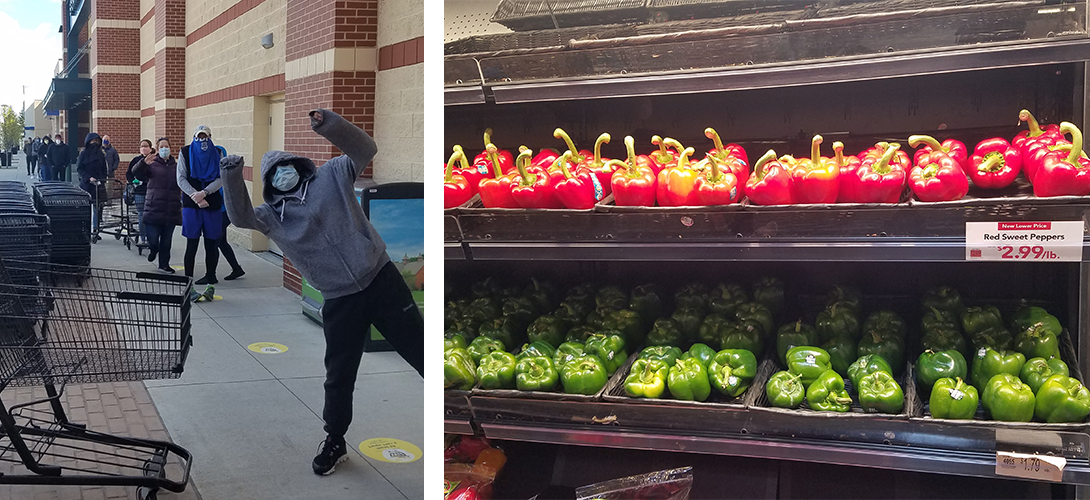 Photobombing in line and impeccably aligned peppers, including the elusive favorite red pepper (previously hard to come by in early pandemic days).
Photobombing in line and impeccably aligned peppers, including the elusive favorite red pepper (previously hard to come by in early pandemic days).
Day 42: My three-week stock of groceries is running low, so, rather than embark on another three-hour shopping ordeal and risk contact with other shoppers, I’m trying Instacart for the first time. Many products are out of stock, but I am lucky enough to check off most of my list.
Adding items to the cart was the easy part. There are no time slots for delivery within the next week! So begins the battle to refresh the page until a delivery window opens. After much refreshing, I get lucky with a delivery three days away.
Day 45: About an hour before my groceries are scheduled to arrive, I notice a text from an unknown number. My Instacart shopper has started her rounds. I can see her request to replace individual apples with a prepackaged bag, quicker and simpler than selecting the best apples in the heap. In pandemic times, I guess I can’t be too picky. It feels so foreign to see a stranger gathering my groceries in real-time through the app’s seemingly self-checking grocery list.
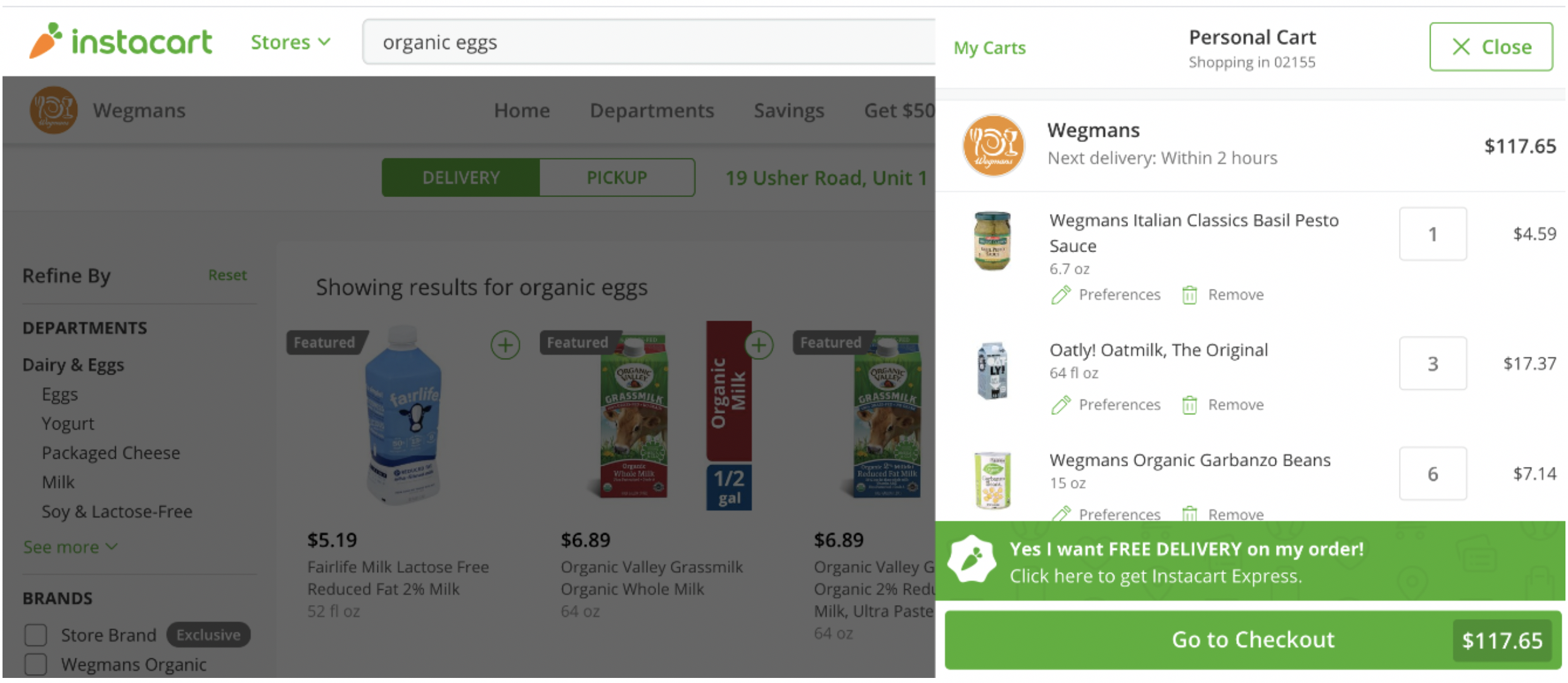
Instacart shopping screenshot.
Rising to the Challenge - Experimentation & Rapid Ideation
Watching one grocery store’s reaction to change throughout the pandemic has been eye-opening. It has revealed a resiliency of human spirit, and admirable creativity given the many rounds of “prototyping” that required grocery stores to adapt in a highly fluid situation. What I find the most surprising is how they managed to establish a calm, collected, and orderly environment at the outset, despite an atmosphere of fear and uncertainty.
My first trip on March 13th was marked by a mix of nervous energy and curiosity. Were people stampeding grocery stores to stockpile for an apocalypse? Would I be able to get the few items I needed? Since then, I have felt reassured by quick and decisive actions to maintain order. They continue to experiment and adapt in real-time to changing demands for social distancing needs, and in response to community reactions. Their patience has encouraged calm among shoppers regardless of their feelings about the pandemic.
Kudos to these stores for their ingenuity and quick action. In the first weeks, all anyone talked about were the horror stories of stores completely emptied of food and multiple trips to distant locations to fulfill their shopping lists. Though I have seen this in some stores myself, my local store has been a leader in providing me a less frantic experience.
Wegmans' is not the only store responding well. Others implementing similar social distancing policies within their stores, and some seem to have adopted stricter measures more quickly. Trader Joe’s is one such store. They reduced store occupancy and built outdoor lines weeks before the mainstream implementation of social distancing measures. A unique (and on-brand) detail of their public-facing response has been their sidewalk chalk comments, encouraging and supporting customers while they wait outside. Reminders such as these, and the conversational, friendly tone, help to keep spirits up and acknowledge the unusual nature of the situation.
 A sidewalk chalk message outside of Trader Joe’s reassures customers with positive messaging. The unique placement and use of materials enable them to easily experiment with new measures and messaging.
A sidewalk chalk message outside of Trader Joe’s reassures customers with positive messaging. The unique placement and use of materials enable them to easily experiment with new measures and messaging.
What does it all mean?
These reactive measures are signaling a change that will stretch beyond the initial pandemic. These shifts in shopping behavior have begun that transcend physical stores as more people are turning to online shopping than ever before. The paradigm may be shifting as grocery stores reevaluate their business models and approaches to the customer experience. How do they support in-store shopping with the new norms and expectations around distancing and cleanliness, while accounting for professional shoppers and increased “direct to consumer” demand? What might the future of grocery shopping look like when half the lines are filled with Instacart shoppers? Some stores have already seen this reality. Some have extended hours for professional shoppers to increase the efficiency of online orders without disrupting traditional shoppers.
Are we observing a fundamental change in the food supply chain and grocery store ecosystem? Where will the line be drawn between supply fulfillment centers and traditional store shopping in the future?
This process has given me, and us all, an opportunity to learn from our communities in new ways and to observe human adaptation on a large scale. It is an ideal moment of experiment, test, and prototype as we mold the future of public health and community preparedness. And grocery stores, who live and breathe in this moment, exemplify the resilience and adaptability we need as a society to stay vigilant for whatever comes our way. Have hope and take inspiration from your everyday heroes leading the charge.
__________
Katie Schussheim is a Design Researcher on Essential's Innovation Strategy team.
Essential Design is a leading Innovation Strategy & Design consultancy. We work across the healthcare, consumer, and commercial industries, helping our clients conceive and drive to market comprehensive digital, physical, and service experiences.


